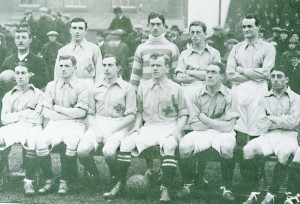See here for coverage by BBC Sport and 10 daily
Submissions can be made at rdg.ac/playerheights and should also include, wherever possible, a photo of the source, the player’s club at the time, date of birth and position played.
See below for details
Release Date 15 May 2020
Football fans looking for something else to do with their weekend are being asked to dig out old player cards and club albums to see if players are getting taller.
It is thought that players have increased in height since the professional game was established in the mid-nineteenth century. However, there is currently not enough data prior to 1950 to show this conclusively.
Football economists from the University of Reading with colleagues from the University of South Australia and Ohio State University are seeking to fill the gap by asking people to submit any records they have of player heights from this period.
One use for the data would be to provide evidence for or against calls to make goals bigger. It will also shed light on whether taller people have an advantage from birth in becoming footballers – and how that advantage has shifted over time, as the general population has become bigger.
“We need the help of football fans everywhere to uncover this data. The more heights we collect, the clearer we’ll be on whether players really have got taller, and by how much” – Dr James Reade, University of Reading
The data will also enable comparisons to be made over eras and to reveal how players in certain position have evolved – for instance to see if midfielders have become shorter, on average, over time.
Professor Adrian Bell, a historian and Dean for Prosperity and Resilience at the University of Reading, said: “Modern-day football is a global industry worth billions of pounds in revenue, yet it still uses laws on goal sizes drawn up in the mid-19th century.
“We suspect that footballers’ body shapes have changed, with more emphasis on fitness and diet, as well as growth in average height in the general population. But up until now, this has never properly been studied among a representative sample of professional footballers.
Dr James Reade, a sports economist at the University of Reading, said: “Making goals bigger to increase the number of goals scored in matches has been a serious suggestion in recent years. Other rules have changed, so it is not inconceivable that this might happen. If governing bodies do want to use changing player sizes as justification, it’s important that decisions are based on solid data.
“We need the help of football fans everywhere to uncover this data. The more heights we collect, the clearer we’ll be on whether players really have got taller, and by how much.”
Football laws created by the newly-formed Football Association in 1863 stipulated that goalposts should be 8 yards (7.2m) apart. The addition of a crossbar was not made mandatory until 1882, and this was required to be 8ft (2.44m) above the ground.
Some plans have been drawn up in the past to increase the size of goals. In 1996, then-FIFA President Sepp Blatter publicly questioned the size of goals, arguing they should be made 50cm wider and 25cm taller. However, this plan was scrapped due to opposition.
Fans wanting to contribute to the new project should submit observations of the heights of professional players at any club in the world from between 1870 and 1950. These are often found on collectible football cards, club year books and other publications.
For an instance of a celebrity player, it is claimed that Sir Arthur Conan Doyle, the creator of Sherlock Holmes, was goalkeeper for Portsmouth FC in 1891, playing under the name A.C. Smith, and was 6’1’’ in height.


